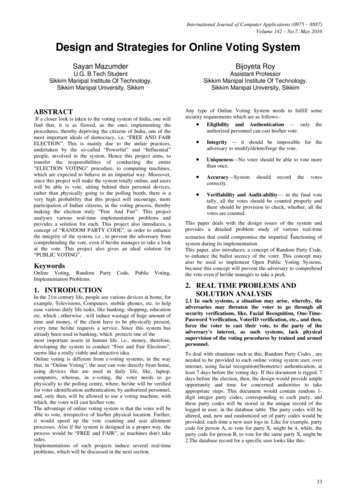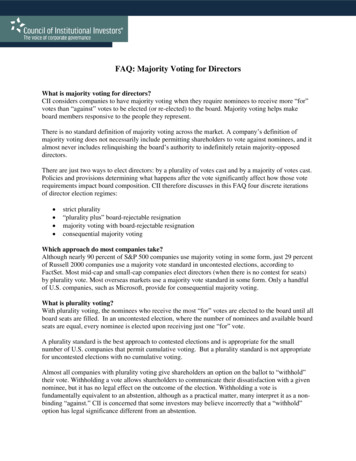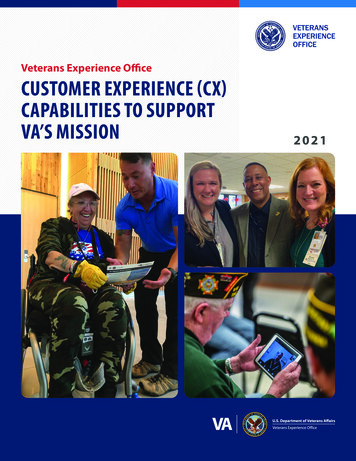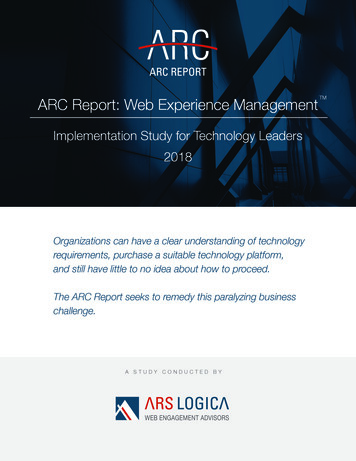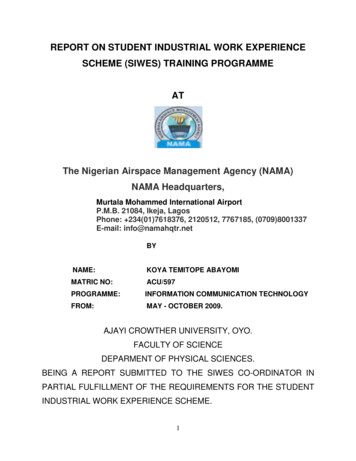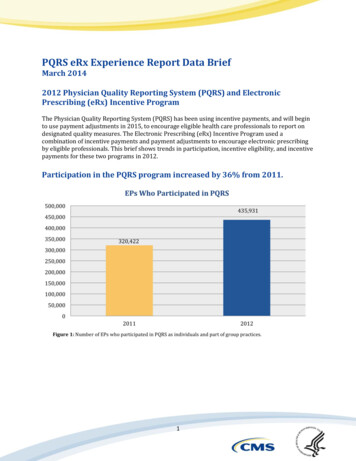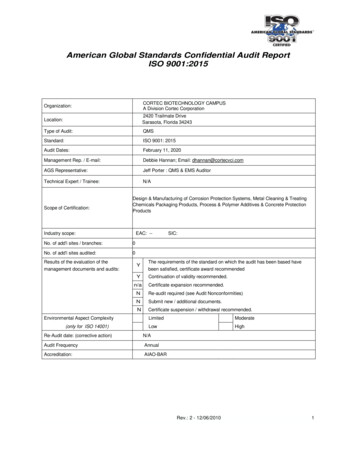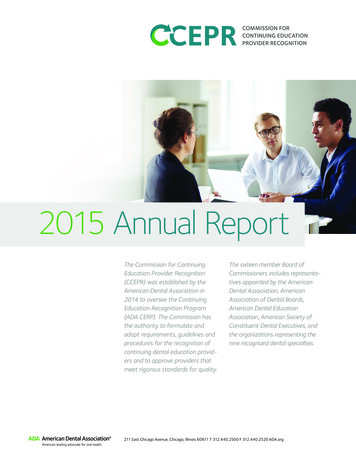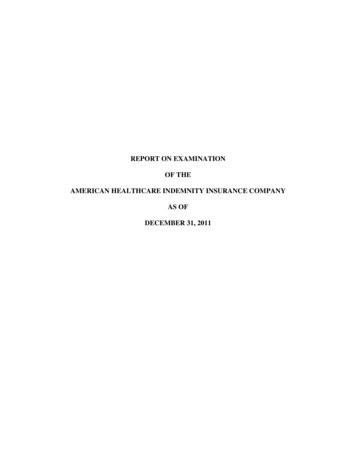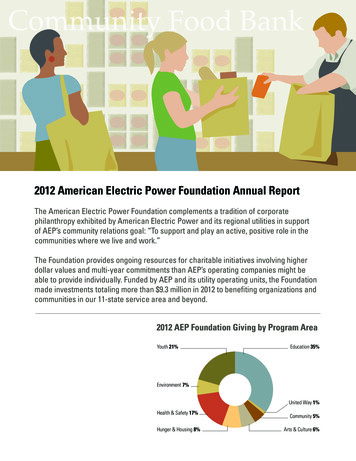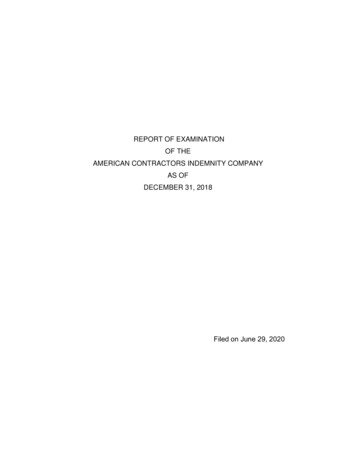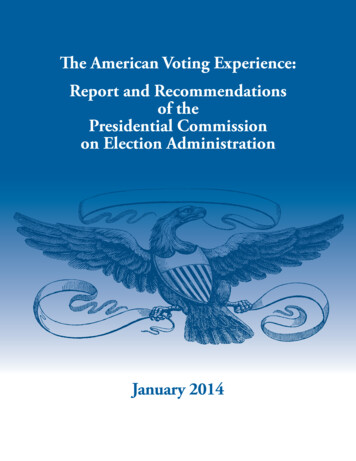
Transcription
The American Voting Experience:Report and Recommendationsof thePresidential Commissionon Election AdministrationJanuary 2014
Presidential Commission on Election AdministrationRobert F. Bauer, Co-ChairBenjamin L. Ginsberg, Co-ChairBrian BrittonJoe EchevarriaTrey GraysonLarry LomaxMichele Coleman MayesAnn McGeehanTammy PatrickChristopher ThomasSenior Research Director: Nathaniel Persily
t h e Pre s ide nt ia l Co m m is s io no n E l e c t io n Adm in is t rat io nJanuary 2014Dear Mr. President:We are pleased to submit this Report and Recommendation called for in your ExecutiveOrder 13639, which established this Commission on Election Administration and defined itsmission.Our examination spanned six months of public hearings and included consultations withstate and local election officials, academic experts, and organizations and associations involved in one form or another with voting or election administration. In connection withtestimony provided to the Commission, the Caltech-MIT Voting Technology Project alsoconducted a comprehensive survey of the views of thousands of local election officials aroundthe country. As a result, the Commission presents its unanimous recommendations, togetherwith an array of best practices in election administration, which will significantly improve theAmerican voter’s experience and promote confidence in the administration of U.S. elections.The Commission’s focus in this Report remained resolutely on the voter. We discovered,as officials, experts, and members of the public from across the country testified, that voters’ expectations are remarkably uniform and transcend differences of party and politicalperspective. The electorate seeks above all modern, efficient, and responsive administrativeperformance in the conduct of elections. As the Commission sets out in its Report, electionadministration must be viewed as a subject of sound public administration. Our best election administrators attend closely to the interests, needs, and concerns of all of our voters —in large and small jurisdictions, and in urban and rural communities — just as well-managedorganizations in the private sector succeed by establishing and meeting high standards for“customer service.”This view of administration will not only reduce wait times where they occur, but alsoimprove the quality of administration in many other ways, from the registration processthrough the selection and design of polling places, to improved access for particular communities of voters, such as those with disabilities or limited English proficiency, and overseasand military voters. The Commission has found that the problems encountered with electionadministration overlap and intersect, and improved management at one stage in the process
will yield benefits at later stages. Improving the accuracy of registration rolls, for example,can expand access, reduce administrative costs, prevent fraud and irregularity, and reducepolling place congestion leading to long lines.Consistent with this approach, the Commission’s key recommendations call for: modernization of the registration process through continued expansion of online voterregistration and expanded state collaboration in improving the accuracy of voter lists; measures to improve access to the polls through expansion of the period for voting beforethe traditional Election Day, and through the selection of suitable, well-equipped pollingplace facilities, such as schools; state-of-the-art techniques to assure efficient management of polling places, includingtools the Commission is publicizing and recommending for the efficient allocation ofpolling place resources; and, reforms of the standard-setting and certification process for new voting technology toaddress soon-to-be antiquated voting machines and to encourage innovation and theadoption of widely available off-the-shelf technologies.The Commission is grateful for the opportunity to present this Report and Recommendations on issues central to the quality of voter participation and confidence in our democraticprocess.Respectfully submitted,Robert F. Bauer, Co-ChairBenjamin L. Ginsberg, Co-ChairBrian BrittonJoe EchevarriaTrey GraysonLarry LomaxMichele Coleman MayesAnn McGeehanTammy PatrickChristopher Thomas
Table of Contents andSummary of RecommendationsIntroduction. . . . . . . . . . . . . . . . . . . . . . . . . . . . . . . . . . . . . . . . . . . . . . . . . . . . . . . . . . 1Key RecommendationsVoter Registration . . . . . . . . . . . . . . . . . . . . . . . . . . . . . . . . . . . . . . . . . . . . . . . .Access to the Polls . . . . . . . . . . . . . . . . . . . . . . . . . . . . . . . . . . . . . . . . . . . . . . . .Polling Place Management . . . . . . . . . . . . . . . . . . . . . . . . . . . . . . . . . . . . . . . . .Voting Technology . . . . . . . . . . . . . . . . . . . . . . . . . . . . . . . . . . . . . . . . . . . . . . .3334I. Definition of the Charge . . . . . . . . . . . . . . . . . . . . . . . . . . . . . . . . . . . . . . . . . . . . . 5II. Setting the Stage: Background for the Recommendations. . . . . . . . . . . . . . . . . . . . 9A. Variation in Administration: “Does One Size Fit All?” . . . . . . . . . . . . . . . . . . . 9The diversity and decentralization of the U.S. election systemcautions against nationwide rules, but all jurisdictions facesome common challenges in registering voters, castingballots, and counting votes.B. The Issue of Resources. . . . . . . . . . . . . . . . . . . . . . . . . . . . . . . . . . . . . . . . . . . 10Election needs are often the last to receive attention fromstate and local budgetary authorities, well behind publicsafety, education, and transportation.C. The Technology Challenge. . . . . . . . . . . . . . . . . . . . . . . . . . . . . . . . . . . . . . . . 11A large share of the nation’s voting machines are now almosta decade old and starting to break down. With no federalappropriations on the horizon, election authorities are ontheir own to do more with less.D. Addressing Long Lines—and the Standard for Judging What Is “Long”. . . . 13No citizen should have to wait more than 30 minutesto vote; jurisdictions can solve the problem of long linesi
through a combination of planning, including use of thetools noted in this Report, and the efficient allocation ofresources.E. Disproportionate Impacts and Enforcement of Existing Federal Law . . . . . . 15Compliance with numerous existing laws continues to beinconsistent or inadequate, and enforcement must bestrengthened. UOCAVA and the MOVE Act for military andoverseas voters Sections 203 and 208 of the Voting Rights Act forvoters with limited English proficiency Americans with Disability Act and Help AmericaVote Act for voters with disabilities The National Voter Registration Act for voterswho register with a Department of MotorVehicles or other covered agencyF. Professionalism in Election Administration. . . . . . . . . . . . . . . . . . . . . . . . . . . 18Because the selection of election officials on a partisan basiscan risk public confidence in the quality and impartialityof administration, the responsible department or agency inevery state should have on staff individuals chosen solely onthe basis of experience and expertise.G. Incorporation of Recommendations Made byOther Commissions and Organizations. . . . . . . . . . . . . . . . . . . . . . . . . . . . . . 19III. Recommendations and Best Practices. . . . . . . . . . . . . . . . . . . . . . . . . . . . . . . . . . 22A. Voter Registration: List Accuracy and Enhanced Capacity. . . . . . . . . . . . . . . 22Recommendation: States should adopt online voter registration. . . . . . . . . 23Best Practice: Online registration tools, like the ones madeavailable on the Commission’s website, can facilitate registrationthrough web portals of other state agencies and outside groups. . . . . . . . 27ii
Recommendation: Interstate exchanges of voterregistration information should be expanded. . . . . . . . . . . . . . . . . . . . . . . . . 27Best Practice: States should join interstate programs thatshare data and synchronize voter lists so that states, on theirown initiative, come as close as possible to creating anaccurate database of all eligible voters. . . . . . . . . . . . . . . . . . . . . . . . . . . . 29Recommendation: States should seamlessly integratevoter data acquired through Departments of Motor Vehicleswith their statewide voter registration lists. . . . . . . . . . . . . . . . . . . . . . . . . . . 30Best Practice: States should adopt procedures like thosein Delaware that lead to the seamless integration ofdata between DMVs and elction offices. . . . . . . . . . . . . . . . . . . . . . . . . 31B. Improved Management of the Polling Place . . . . . . . . . . . . . . . . . . . . . . . . . . 311. Polling Place Location and Design. . . . . . . . . . . . . . . . . . . . . . . . . . . . . . . . 32Best Practice: Polling places should be locatedclose to voters and designed to have sufficient spaceand parking, accessibility for voters with disabilities,and adequate infrastructure. . . . . . . . . . . . . . . . . . . . . . . . . . . . . . . . . . . . 32Best Practice: Local officials should maintain adiagram of every polling place used in the jurisdictionthat provides room dimensions, location of power outlets,the proposed positioning of voting and voter processingequipment, the entry and exit routes, and signage requiredby the Americans with Disabilities Act. . . . . . . . . . . . . . . . . . . . . . . . . . . 33Best Practice: The diagrams should be maintained in theclerk’s office, provided to the election official responsiblefor the polling location on Election Day, and updatedbefore every election. . . . . . . . . . . . . . . . . . . . . . . . . . . . . . . . . . . . . . . . . . 33Recommendation: Schools should be used as polling places;to address any related security concerns, Election Day shouldbe an in-service day. . . . . . . . . . . . . . . . . . . . . . . . . . . . . . . . . . . . . . . . . . . . . . 33iii
Recommendation: States should consider establishingvote centers to achieve economies of scale in polling placemanagement while also facilitating voting atconvenient locations. . . . . . . . . . . . . . . . . . . . . . . . . . . . . . . . . . . . . . . . . . . . . 352. Management of Voter Flow . . . . . . . . . . . . . . . . . . . . . . . . . . . . . . . . . . . . . 36Best Practice: Employ “line walkers” to address potentialproblems among voters before they reach a check-in stationwhere their registration is verified. . . . . . . . . . . . . . . . . . . . . . . . . . . . . . . 36Best Practice: Voters should be given better informationon line length before they go to the polling place, such asproviding an internet feed from individual polling places. . . . . . . . . . . . 37Best Practice: Election officials should employ insightsfrom queuing theory concerning the flow of voters, the pointsof service in the polling place, and the time it takes to verifyregistration and to vote. . . . . . . . . . . . . . . . . . . . . . . . . . . . . . . . . . . . . . . 38Best Practice: To prepare for Election Day, jurisdictionsmust accurately estimate the number of registered votersper precinct and the share that will turn out, and be ableto react to data gathered in the critical three-month periodprior to an election when the factors affecting turnout aremost relevant. . . . . . . . . . . . . . . . . . . . . . . . . . . . . . . . . . . . . . . . . . . . . . . 40Best Practice: Election officials should pretest the lengthof time it takes an average voter to vote a ballot in orderto accurately estimate how many poll workers, machines andvoting stations will be needed at each voting location. . . . . . . . . . . . . . . 40Best Practice: The sample ballot, along with polling locationsand times, should be made available to voters no later than thebeginning of in-person early voting or three weeks before Election Dayso that voters will be able to make their choices before enteringthe polling place. . . . . . . . . . . . . . . . . . . . . . . . . . . . . . . . . . . . . . . . . . . . . 41Best Practice: If the state law allows, jurisdictionsshould reduce the length and complexity of the ballot inPresidential election years. . . . . . . . . . . . . . . . . . . . . . . . . . . . . . . . . . . . . 41iv
Recommendation: Jurisdictions should develop models andtools to assist them in effectively allocating resources acrosspolling places. . . . . . . . . . . . . . . . . . . . . . . . . . . . . . . . . . . . . . . . . . . . . . . . . . 42Best Practice: Election officials need greater access toindustrial engineering tools that are regularly employedby the private sector to help manage customer servicequeues. . . . . . . . . . . . . . . . . . . . . . . . . . . . . . . . . . . . . . . . . . . . . . . . . . . . . 42Best Practice: Election officials should take advantageof the “resource calculators” available through the Commissionweb site at www.supportthevoter.gov and hosted by theCal Tech-MIT Voting Technology Project to aid in makingdecisions on how to allocate limited voting resources. . . . . . . . . . . . . . . 43Best Practice: Election officials should keep track of waittimes at individual polling places using simple managementtechniques, such as recording line length at regular intervalsduring Election Day and giving time-stamped cards to votersduring the day to monitor turnout flow. . . . . . . . . . . . . . . . . . . . . . . . . . 43Best Practice: In polling places with a history of long lines,local election officials should analyze the reasons for excessivewait times and develop plans for avoiding the problemin the future. Local election officials should provide copiesof these plans to the relevant chief state election official. . . . . . . . . . . . . . 43Recommendation: Jurisdictions should transition toelectronic pollbooks. . . . . . . . . . . . . . . . . . . . . . . . . .
American voter’s experience and promote confidence in the administration of U.S. elections. The Commission’s focus in this Report remained resolutely on the voter. We discovered, as officials, experts, and members of the public from across the country testified, that vot-ers’ expectations are remarkably uniform and transcend differences of party and political perspective. The electorate .
